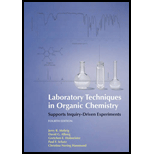
Interpretation:
A suitable solvent to analyze the mixture of alcohol and
Concept introduction:
Thin-layer chromatography is an analytical technique used to identify whether two compounds are identical or not and also to find the number of compounds in a mixture.
Metal, glass or plates made of plastics are utilized in TLC that are coated by a thin layer of adsorbent and it acts as a stationary phase. The stationary phase usually used is polar silica gel. A mixture of solvents or single pure solvent is the mobile. It is also known as a developing agent. Mostly nonvolatile solid organic samples are analyzed by thin-layer chromatography.However, TLC cannot be used for volatile liquid compounds because it leads to loss of the sample by evaporation from the TLC plate.
In TLC analysis, mixture in a low quantity is taken for separation and dissolved in the suitable solvent and applied on the TLC plate. Then TLC plate is kept in the closed chamber immersed in mobile phase known as developing solvent. Through capillary action the solvent rises on the stationary phase. As the solvent rises on the plate, the sample is distributed between the mobile phase and the stationary phase on the basis of their retention values. The more the compound interacts with the stationary phase, the more slowly it moves on the TLC plate. When silica gel that is polar in nature behaves as the stationary phase then mobile solvent rises with the nonpolar substances up on the plate most rapidly. In the chromatogram the polar substances rise up plate with lowest rate.
The ratio of distances covered by the compound to the distance covered by developing solvent or mobile front is known as retention factor
The
Trending nowThis is a popular solution!

Chapter 18 Solutions
Laboratory Techniques in Organic Chemistry
- The surface of the silica gel has a structure that looks like this diagram below. Suppose you used a plate coated with silica gel, with propanone, CH3COCH3, as the solvent for thin-layer chromatography. Suppose also that the mixture you were trying to identify contained benzaldehyde benzanilide phenol 1) rank the Rf value from large to small 2) name the IMF between each compound and the silica gel OH OH OH -0-Si-O-Si-O-Si-O- O main body of silica structurearrow_forwardThe surface of the silica gel has a structure that looks like this diagram below. Suppose you used a plate coated with silica gel, with propanone, CH3COCH3, as the solvent for thin-layer chromatography. Sno Suppose also that the mixture you were trying to identify contained • benzaldehyde •benzanilide • phenol 1) rank the Rf Value from large to small 2) name the IMF between each compound and the silica gel OH OH main body of silica structurearrow_forwardExplain why TLC cannot be used for some volatile low molecular weight substances such as toluene.arrow_forward
- What is the function of the sulfuric acid in the dehydration of alcohols to form alkenes? Why was it important to keep the Gas chromatograph close to room temperature during the analysis of the alkene mixture?arrow_forwardUse a suitable model to explain how separation and identification of a mixture of organic compounds can be achieved with a thin layer chromatographic (TLC) technique.arrow_forward1.0 g of a compound A is prepared in 100 mL of water, and then extracted with 50 mL of ether. After the extraction, 0.25 g of the compound was recovered from the ether layer. What is the partitioning coefficient([A]ether/[A]water) for this compound in the system used? 50 ml ether 0g 0.25 g 1g 100 ml water O 4.0 O 3.0 O 1.5 O 0.75 O 0.25 O 0.67arrow_forward
- Consider a sample that is a mixture composed of biphenyl, benzoic acid, and benzyl alcohol. Predict the order of elution of the components in this mixture. Assume that the chromatography uses a silica column, and the solvent system is based on cyclohexane, with an increasing proportion of methylene chloride being added as a function of time.arrow_forwardThree sample, X (neutral), Y (basic), and Z (acidic), were mixed and dissolved together in dichloromethane. Propose a method to separate all given sample individually using the combination of liquid-liquid extraction, crystallization, distillation, and sublimation technique.arrow_forwardAcetone and isopropyl alcohol are generally not suitable for use in extraction, but are frequently used as recrystallization solvents. Explainarrow_forward
- Diethyl ether and methylene chloride are generally not suitable for use in recrystallization, but are frequently used as extraction solvents. Explainarrow_forwardGiven a mixture of benzoic acid, 2-naphthol and p-dimethoxybenzene in t-butyl methyl ether. Using the following reagents: NaHCOs, NAOH and HCI. Draw a flow chart showing: a) How to separate the three components of this mixture? b) Identify the aqueous and organic layers in each step. c) Identify the number of extraction step.arrow_forwardThe compounds biphenyl and naphthalene are presented in a mixture. Can hexane be used as a solvent to separate the compounds by column chromatography with silica gel as the stationary phase? Why or why not.arrow_forward
 EBK A SMALL SCALE APPROACH TO ORGANIC LChemistryISBN:9781305446021Author:LampmanPublisher:CENGAGE LEARNING - CONSIGNMENT
EBK A SMALL SCALE APPROACH TO ORGANIC LChemistryISBN:9781305446021Author:LampmanPublisher:CENGAGE LEARNING - CONSIGNMENT
